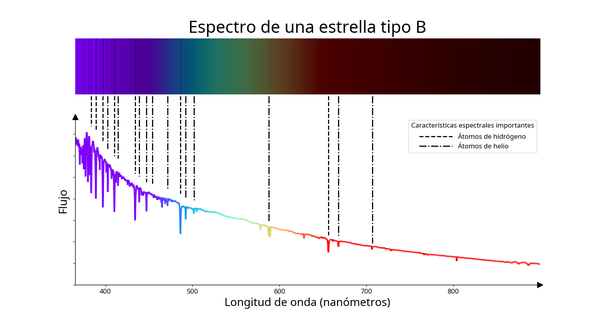This page describes an image Espectro de una estrella tipo B
Download PDF File (PDF file 73.08 kB)
Diagram caption:
Espectro de la estrella tipo B HD 258982. El color de la línea entre 400 nm y 700 nm corresponde aproximadamente al color en que el ojo humano vería la luz de esa longitud de onda. Por debajo de 400 nm y por encima de 700 nm, donde el ojo humano puede ver poca o ninguna luz, las líneas son de color azul y rojo, respectivamente.
Las líneas negras muestran las líneas de absorción espectral causadas por átomos e iones de diferentes elementos de la atmósfera de la estrella. Estos átomos e iones absorben en longitudes de onda específicas, provocando líneas nítidas y oscuras en el espectro. La intensidad de estas líneas depende de la temperatura de la atmósfera de la estrella. Dos estrellas formadas por la misma mezcla de elementos pueden tener espectros con conjuntos de líneas muy diferentes si sus atmósferas tienen temperaturas distintas. En las estrellas tipo B, las líneas más importantes son las causadas por los átomos de helio. Estas líneas son más intensas en las estrellas tipo B y más débiles en los tipos más calientes y más fríos. Las líneas de los átomos de hidrógeno también están presentes, pero no son tan intensas como en las estrellas tipo A más frías.
Diagram credit: IAU OAE/SDSS/Niall Deacon.
Diagram translation status: Not yet approved by a reviewer
Diagram translators: Samantha Brown-Sevilla
Related glossary terms:
B-type Star
, Spectrum
, Wavelength
Categories:
Stars
Created with support from: OAE Main Office
Diagram license: Creative Commons Reconocimiento 4.0 Internacional (CC BY 4.0) Creative Commons Reconocimiento 4.0 Internacional (CC BY 4.0) icons
Want to make your own version of this diagram? Then have a look at the code that
produced this diagram on Github
Linked Diagrams
Espectro de una estrella tipo OEspectro de una estrella tipo A
Espectro de una estrella tipo F
Espectro de una estrella tipo G
Espectro de una estrella tipo K
Espectro de una estrella tipo M
Tipos espectrales estelares
Tipos espectrales estelares - bandas
In Other Languages
Inglés: Spectrum of a B-type starItaliano: Spettro di una stella di tipo B
Francés: Spectre d'une étoile de type B
Árabe: طيف لنجم من النوع B
Want to create your own translation? Then have a look at the code that produced this diagram on Github
The diagram captions presented on the OAE website were written, translated and reviewed by a collective effort from the OAE, the OAE Centers and Nodes, the OAE National Astronomy Education Coordinators (NAECs) and other volunteers. You can find a full list of credits for our translation project here. All media file captions are released under a Creative Commons CC BY-4.0 license and should be credited to "IAU OAE". The media files themselves may have different licenses (see above) and should be credited as listed above under "credit".
If you notice a error in this diagram or its caption then please get in touch.









